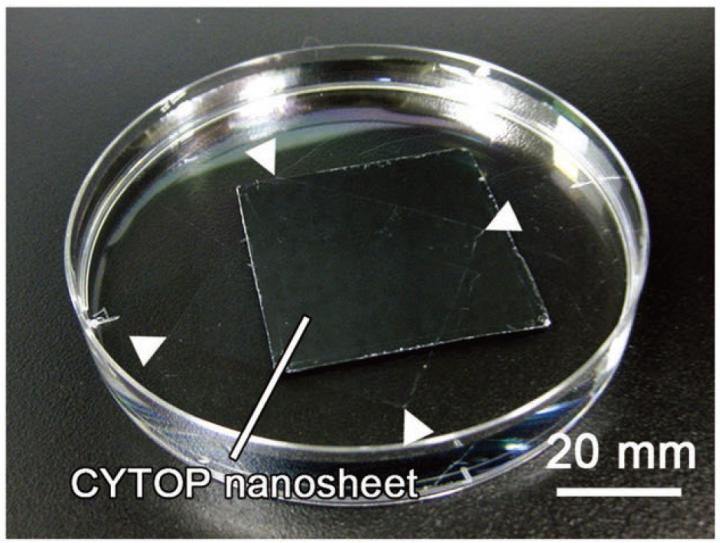New wrapping material enables high quality bioimaging

This is the CYTOP® nanosheet developed in the study. Credit: Zhang H. et al., Advanced Materials, Aug. 11, 2017
Be it cosmology or biology, the advancement of science largely relies on the advancement of measuring instruments and methodology. In the past couple of decades, scientists' passion to see the invisible has vastly improved microscopes and other equipment resulting in high-resolution images, three-dimensional images, and longer recording times of biological samples. However, current setups do not prevent them from drying and deforming during observations, resulting in blurred images.
Scientists from Hokkaido University and Tokai University in Japan have developed a nanosheet made of a fluorine-containing polymer known as CYTOP® and investigated its effectiveness in producing clear images when wrapped around biological samples. CYTOP® is a commercially available chemical agent developed by Asahi Glass Co., Ltd.
The researchers successfully produced a nanosheet of CYTOP® by spreading its solution on a layer of poly-vinyl-alcohol (PVA). The nano-thin layer of CYTOP® was easily detached from the PVA layer by soaking them in water. The thickness of the nanosheet could be adjusted by changing the concentration of its solution. The nanosheet retained CYTOP®'s high water repellent properties which should help retain a sample's water content when used as wrapper.
The team then tested the nanosheet's wrapping properties by using alginate hydrogel to simulate biological samples such as tissue. They found that the gel retained 60% of its water content after 24 hours when wrapped whereas the unwrapped gel became totally dehydrated after about 10 hours.
Experimenting with various thicknesses, they found that a 133-nm-thick sheet provides sufficient water retention and surface adhesion which is necessary for fixing samples to the cover slip.
They next applied an actual biological sample: 1-mm thick brain slices from mice. Without a CYTOP® wrap, evaporation of the embedded water caused local, non-uniform sample shrinkage, leading to blurred images. By wrapping the brain slices in a CYTOP® nanosheet, however, images with a high spatial resolution could be obtained from scanning a large area (more than 750 μm x 750 μm) over a long time (about 2 hours).
Similar results were obtained even when the sample was embedded in agarose gel — a common technique used for mounting biological tissues that could disturb the clarity of taransparentized samples — without disturbing the clarity.
“The wrapping technique is still at an early stage, but it establishes and verifies the superiority of nanosheet wrapping for tissue imaging,” say the researchers of the paper published in Advanced Materials.
Media Contact
All latest news from the category: Materials Sciences
Materials management deals with the research, development, manufacturing and processing of raw and industrial materials. Key aspects here are biological and medical issues, which play an increasingly important role in this field.
innovations-report offers in-depth articles related to the development and application of materials and the structure and properties of new materials.
Newest articles

NASA: Mystery of life’s handedness deepens
The mystery of why life uses molecules with specific orientations has deepened with a NASA-funded discovery that RNA — a key molecule thought to have potentially held the instructions for…

What are the effects of historic lithium mining on water quality?
Study reveals low levels of common contaminants but high levels of other elements in waters associated with an abandoned lithium mine. Lithium ore and mining waste from a historic lithium…

Quantum-inspired design boosts efficiency of heat-to-electricity conversion
Rice engineers take unconventional route to improving thermophotovoltaic systems. Researchers at Rice University have found a new way to improve a key element of thermophotovoltaic (TPV) systems, which convert heat…



